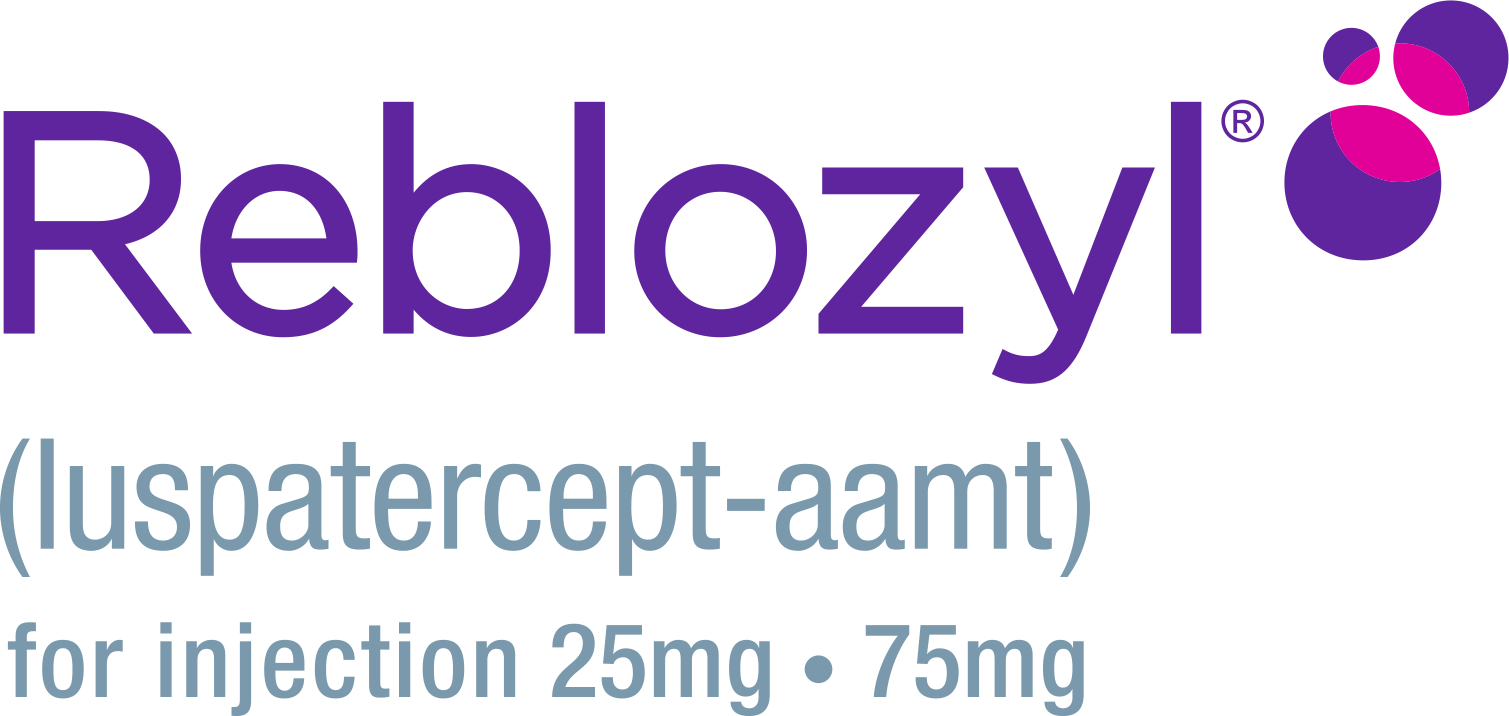Patients (%) |
REBLOZYL(n=182) |
Epoetin Alfa(n=181) |
|---|---|---|
| ITT POPULATION |
63.7% (n=116) |
42.0% (n=76) |
| BASELINE TB <4 U/8 weeks |
72.9% | 55.9% |
| ≥4 U/8 weeks | 46.9% | 20.0% |
| BASELINE sEPO <200 U/L |
71.0% | 51.0% |
| >200 to <500 U/L | 35.1% | 7.9% |
| SF3B1 MUTATION STATUS Mutated |
72.8% | 41.6% |
| Non-mutated | 49.2% | 40.3% |
| RS STATUS RS+ |
67.7% | 39.2% |
| RS- | 53.1% | 50.0% |
EFFICACY and safety: DURABILITY AND SUBGROUPS
REBLOZYL delivered durable RBC-TI1
Durable transfusion-free time exhibited across all patients1
Secondary endpoint: Median duration of RBC-TI ≥12 weeks (Week 1-EOT)
Duration of RBC-TI for ≥12 weeks2

Analysis limitations: Duration RBC-TI >12 weeks was not powered to detect statistical significance.1
Data cutoff date: August 2022.

From the full analysis 48-week follow-up
REBLOZYL results across key subgroups2
Response rates of the preplanned subgroup analysis of RBC-TI for ≥24 weeks (Weeks 1-48)2
Select graphic view or table view to explore data

Analysis limitations:
- Subgroup analyses were performed for the primary and key secondary efficacy endpoints. Formal hypothesis testing was not performed
- These analyses should not be interpreted to determine treatment differences between arms in these subgroups because of limited sample size, lack of statistical hypothesis testing, and the increased probability of a false-positive finding
*P<0.0001.
Data cutoff date: September 2023.
From the full analysis
Nearly 80% of patients in COMMANDS had baseline sEPO ≤200 U/L2†
Among patients with baseline sEPO ≤200 U/L
RBC-TI for ≥12 weeks and mean Hgb increase ≥1.5 g/dL3

Duration of RBC-TI for ≥12 weeks2

On REBLOZYL, ~38% of EPO >200 patients achieved a mean Hgb increase of ≥1.5 g/dL and TI for ≥12 weeks vs ~11% of patients on epoetin alfa. REBLOZYL patients also achieved a mean of 1 year of TI compared to patients on epoetin alfa who only experienced a mean of 0.5 years of TI.2,3
The primary endpoint for Weeks 1-24, RBC-TI ≥12 weeks with concurrent mean Hgb increase ≥1.5 g/dL, was achieved by 86 (58.5%) patients in the REBLOZYL arm versus 48 (31.2%) patients in the epoetin alfa arm (P<0.0001).4
Analysis limitations:
- Subgroup analyses were performed for the primary and key secondary efficacy endpoints. Formal hypothesis testing was not performed
- These analyses should not be interpreted to determine treatment differences due to limited sample size, lack of statistical hypothesis testing, and increased probability of a false-positive finding
†145 patients in the REBLOZYL arm and 144 patients in the epoetin alfa arm had sEPO ≤200 U/L.2
Data cutoff date: March 2023.
Duration of RBC-TI for ≥12 weeks2

From the full analysis 48-week follow-up‡
COMMANDS had 99 RS- patients, the most of any Phase 3, LR-MDS study3,5,6
Among RS- patients
RBC-TI for ≥12 weeks and mean Hgb increase ≥1.5 g/dL3

Duration of RBC-TI for ≥12 weeks2

Duration of RBC-TI for ≥12 weeks2


Duration for REBLOZYL arm was not reached (NR) because >50% of patients were still transfusion independent at time of analysis2

The primary endpoint for Weeks 1-24, RBC-TI ≥12 weeks with concurrent mean Hgb increase ≥1.5 g/dL, was achieved by 86 (58.5%) patients in the REBLOZYL arm versus 48 (31.2%) patients in the epoetin alfa arm (P<0.0001).4
Analysis limitations:
- Subgroup analyses were performed for the primary and key secondary efficacy endpoints. Formal hypothesis testing was not performed
- These analyses should not be interpreted to determine treatment differences due to limited sample size, lack of statistical hypothesis testing, and increased probability of a false-positive finding
‡Exploratory endpoint.
Data cutoff date: September 2023.
Watch clinical experts discuss treating key patient groups

Using sEPO ≤200 as a parameter in the LR-MDS treatment algorithm
George Yaghmour, MD
USC Norris Comprehensive Cancer Center & Hospital
Los Angeles, CA

Clinical response and duration in the RS-subgroups
Jamie Koprivnikar, MD
John Theurer Cancer Center Hackensack University Medical Center
Hackensack, NJ
CI=confidence interval; EOT=end of treatment; EPO=erythropoietin; Hgb=hemoglobin; ITT=intent to treat; KM=Kaplan-Meier; LR-MDS=lower-risk myelodysplastic syndromes; MDS=myelodysplastic syndromes; RBC=red blood cell; RBC-TI=red blood cell transfusion independent; RS=ring sideroblast; sEPO=serum erythropoietin; TB=transfusion burden; TI=transfusion independence.
References: 1. Platzbecker U, Della Porta MG, Santini V, et el. Efficacy and safety of luspatercept versus epoetin alfa in erythropoiesis-stimulating agent-naive, transfusion-dependent, lower-risk myelodysplastic syndromes (COMMANDS): interim analysis of a phase 3, open-label, randomised controlled trial (supplementary appendix). Lancet. 2023; published online June 10, 2023. https://doi.org/10.1016/S0140-6736(23)00874-7 2. Garcia-Manero G, Platzbecker U, Santini V, et al. Efficacy and safety of luspatercept versus epoetin alfa in erythropoiesis-stimulating agent-naive patients with transfusion-dependent lower-risk myelodysplastic syndromes: full analysis of the COMMANDS trial. Presented at: American Society of Hematology (ASH) Annual Meeting and Exposition. December 9-12, 2023. San Diego, CA. Abstract 193. 3. Data on file. BMS-REF-ACE-536-00689. Princeton, NJ: Bristol-Myers Squibb Company; 2024. 4. REBLOZYL [US Prescribing Information]. Summit, NJ: Celgene Corporation; 2024. 5. Fenaux P, Santini V, Spiriti MAA, et al. A phase 3 randomized, placebo-controlled study assessing the efficacy and safety of epoetin-a in anemic patients with low-risk MDS. Leukemia. 2018;32(12):2648-2658. 6. Greenberg PL, Sun Z, Miller KB, et al. Treatment of myelodysplastic syndrome patients with erythropoietin with or without granulocyte colony-stimulating factor: results of a prospective randomized phase 3 trial by the Eastern Cooperative Oncology Group (E1996). Blood. 2009;144(12):2393-2400.

